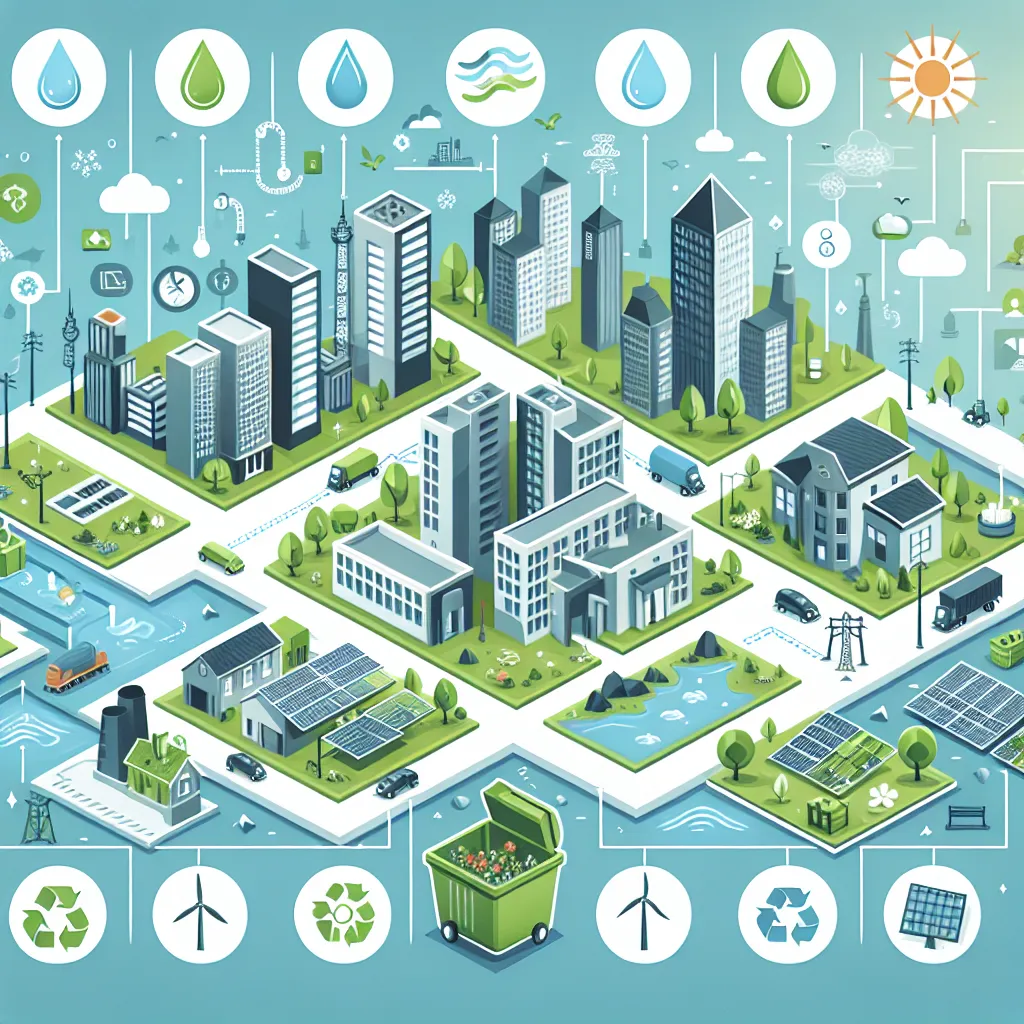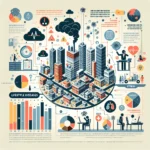Welcome to our IELTS Reading practice session focused on “Urbanization and the Challenge of Resource Management.” This topic has been increasingly prevalent in recent IELTS exams, reflecting its global significance. As cities continue to grow rapidly worldwide, the challenges of managing resources in urban areas have become a pressing concern. Based on current trends and the frequency of this subject in past exams, it’s highly likely that you may encounter a similar theme in your upcoming IELTS Reading test.
In this practice, we’ll explore a passage that mirrors the complexity and depth you might find in the actual IELTS exam. Remember, the Reading section requires you to demonstrate your ability to understand complex texts, identify key information, and interpret the author’s opinions. Let’s dive into this crucial topic and sharpen your skills for success in your IELTS Reading test.
 Urban resource management challenges
Urban resource management challenges
Practice Passage
Urbanization and Resource Management: A Global Challenge
Urbanization, the process by which an increasing percentage of a country’s population comes to live in cities, is one of the most significant global trends of the 21st century. While cities offer numerous opportunities for economic growth and social development, they also present formidable challenges in terms of resource management. As urban populations swell, the demand for resources such as water, energy, and food intensifies, putting unprecedented pressure on existing infrastructure and natural ecosystems.
One of the primary challenges facing urban planners and policymakers is water management. Cities require vast quantities of water for domestic, industrial, and commercial use. However, many urban areas, particularly in developing countries, struggle with water scarcity and inadequate distribution systems. In some rapidly growing cities, up to 50% of the water supply is lost due to leakages and illegal connections. Moreover, urban water bodies often suffer from pollution, further exacerbating the water crisis.
Energy consumption in cities is another critical concern. Urban areas consume about 75% of the world’s energy and are responsible for a similar percentage of global CO2 emissions. The concentration of energy use in cities contributes significantly to climate change, while also straining power grids and increasing the risk of blackouts. Transitioning to renewable energy sources and improving energy efficiency in buildings and transportation systems are crucial steps in addressing this challenge.
Waste management poses yet another significant hurdle for expanding urban centers. As consumption patterns change and populations grow, cities generate enormous amounts of solid waste. Inadequate waste collection and disposal systems lead to environmental degradation, health hazards, and lost economic opportunities. Many cities in developing countries struggle with open dumping and burning of waste, practices that contribute to air and water pollution.
Food security is an often-overlooked aspect of urban resource management. As cities expand, they often encroach on agricultural land, reducing local food production capacity. This leads to increased reliance on long-distance food transportation, which not only raises costs but also contributes to greenhouse gas emissions. Urban food systems must be reimagined to ensure sustainable and equitable access to nutrition for all city dwellers.
The challenges of urban resource management are interconnected and require holistic solutions. Many cities are now adopting the concept of “circular economy” to address these issues. This approach aims to minimize waste and make the most efficient use of resources by recycling, reusing, and regenerating materials. For instance, some cities are implementing waste-to-energy systems that convert organic waste into biogas for electricity generation.
Smart city technologies are also playing an increasingly important role in urban resource management. Internet of Things (IoT) devices and data analytics are being used to optimize water distribution, manage energy consumption, and improve waste collection routes. These technologies can help cities become more efficient and responsive to the needs of their residents.
Green infrastructure is another key strategy in sustainable urban development. This includes creating parks, urban forests, and green roofs, which not only improve quality of life but also help manage stormwater, reduce the urban heat island effect, and support biodiversity. Cities like Singapore have become global leaders in integrating nature into urban landscapes, demonstrating the potential for harmonious coexistence between city life and natural ecosystems.
As the world continues to urbanize, the way we manage resources in cities will have profound implications for global sustainability. Innovative approaches to urban planning, technology adoption, and community engagement will be crucial in creating cities that are not only centers of economic activity but also models of efficient and sustainable resource use. The future of our planet may well depend on how effectively we rise to the challenge of urban resource management in the coming decades.
Questions
True/False/Not Given
Determine if the following statements are True, False, or Not Given based on the information in the passage.
- Urbanization is exclusively a 21st-century phenomenon.
- Water scarcity is a problem only in developing countries’ urban areas.
- Cities consume approximately three-quarters of the world’s energy.
- All cities in developing countries practice open dumping and burning of waste.
- The expansion of cities often leads to a reduction in local food production capacity.
- Smart city technologies are being used to improve waste collection efficiency.
- Green infrastructure in cities only serves aesthetic purposes.
Multiple Choice
Choose the correct letter, A, B, C, or D.
-
According to the passage, what percentage of water supply can be lost in some rapidly growing cities?
A) 25%
B) 35%
C) 50%
D) 75% -
Which of the following is NOT mentioned as a benefit of green infrastructure in cities?
A) Improved quality of life
B) Stormwater management
C) Reduction of urban heat island effect
D) Increased property values -
The concept of “circular economy” in urban resource management aims to:
A) Increase waste production
B) Maximize resource efficiency
C) Expand city boundaries
D) Reduce urban population
Matching Headings
Match the following headings to the correct paragraphs in the passage. Write the correct number (i-viii) next to questions 11-15.
i. The overlooked issue of urban food systems
ii. Technological solutions for resource management
iii. The dual nature of urbanization
iv. Waste management challenges in growing cities
v. Water scarcity and distribution problems
vi. The role of green spaces in urban sustainability
vii. Energy consumption and its environmental impact
viii. Holistic approaches to urban resource challenges
- Paragraph 2: __
- Paragraph 3: __
- Paragraph 4: __
- Paragraph 7: __
- Paragraph 8: __
Answer Key and Explanations
True/False/Not Given
- False – The passage states that urbanization is “one of the most significant global trends of the 21st century,” but does not claim it is exclusive to this century.
- False – The passage mentions that “many urban areas, particularly in developing countries, struggle with water scarcity,” implying that it’s not only a problem in developing countries.
- True – The passage directly states that “Urban areas consume about 75% of the world’s energy.”
- False – The passage states that “Many cities in developing countries struggle with open dumping and burning of waste,” not all cities.
- True – The passage mentions that “As cities expand, they often encroach on agricultural land, reducing local food production capacity.”
- True – The passage states that smart city technologies are “being used to optimize water distribution, manage energy consumption, and improve waste collection routes.”
- Not Given – The passage lists several purposes of green infrastructure but does not comment on whether these are the only purposes.
Multiple Choice
- C) 50% – The passage states, “In some rapidly growing cities, up to 50% of the water supply is lost due to leakages and illegal connections.”
- D) Increased property values – This benefit is not mentioned in the passage.
- B) Maximize resource efficiency – The passage explains that the circular economy approach “aims to minimize waste and make the most efficient use of resources.”
Matching Headings
- v. Water scarcity and distribution problems
- vii. Energy consumption and its environmental impact
- iv. Waste management challenges in growing cities
- ii. Technological solutions for resource management
- vi. The role of green spaces in urban sustainability
Common Mistakes to Avoid
- Overlooking specific details: In questions like the True/False/Not Given, pay attention to qualifiers like “some,” “many,” or “all.”
- Making assumptions: Stick to the information provided in the text. Don’t bring in outside knowledge or make inferences beyond what’s stated.
- Misinterpreting percentages: Be careful with numerical data. Make sure you’re matching the correct figures with the right context.
- Confusing similar concepts: In the matching headings exercise, some options may seem similar. Read carefully to distinguish the main focus of each paragraph.
- Rushing through the passage: Take time to understand the overall structure and main ideas of the text before attempting the questions.
Vocabulary
-
Urbanization (noun) /ˌɜːbənaɪˈzeɪʃən/: The process by which an increasing percentage of a population lives in cities.
-
Formidable (adjective) /fɔːˈmɪdəbl/: Inspiring fear or respect through being impressively large, powerful, intense, or capable.
-
Exacerbate (verb) /ɪɡˈzæsəbeɪt/: Make (a problem, bad situation, or negative feeling) worse.
-
Encroach (verb) /ɪnˈkrəʊtʃ/: Gradually take or begin to take away someone’s rights, position, etc.
-
Holistic (adjective) /həˈlɪstɪk/: Characterized by the belief that the parts of something are intimately interconnected and explicable only by reference to the whole.
Grammar Focus
Passive Voice in Academic Writing
The passage frequently uses passive voice, a common feature in academic and scientific writing. For example:
“Smart city technologies are also playing an increasingly important role in urban resource management.”
Structure: Subject + BE (in appropriate tense) + Past Participle
This structure is useful when:
- The doer of the action is unknown or unimportant.
- The focus is on the action or result rather than who performed it.
- You want to maintain an objective tone in writing.
Practice forming passive sentences related to urban resource management:
- Active: Cities consume vast amounts of energy.
- Passive: Vast amounts of energy are consumed by cities.
Tips for IELTS Reading Success
- Time management is crucial. Allocate your time wisely across all three sections of the Reading test.
- Skim the passage quickly first to get a general idea before diving into the questions.
- Use the headings and first sentences of paragraphs to understand the structure and main ideas.
- For True/False/Not Given questions, be particularly careful with ‘Not Given’ answers. If the information isn’t explicitly stated, don’t make assumptions.
- In Multiple Choice questions, eliminate obviously wrong answers first to increase your chances of selecting the correct option.
- For Matching Headings, look for key words or themes that summarize the main idea of each paragraph.
- Practice regularly with diverse topics to improve your reading speed and comprehension.
Remember, success in IELTS Reading comes from a combination of strong English skills, effective test-taking strategies, and familiarity with various question types. Keep practicing, and you’ll see improvement in your performance.
For more practice on urban-related topics in IELTS, you might find these resources helpful:
- Urban Biodiversity Challenges in Metropolitan Areas
- Urbanization and Waste Management Solutions
- Urban Planning and Green Spaces
Good luck with your IELTS preparation!


